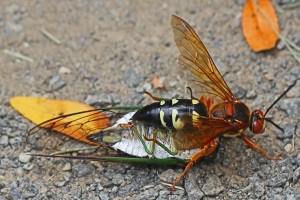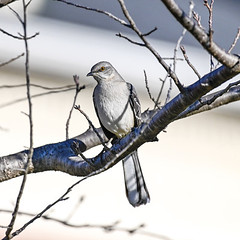Archive for July, 2011|Monthly archive page
Bugs Are Our Friends: Eastern Cicada Killer
I recently participated in a walk, the purpose of which was to look for Dragonflies and Damselflies. We saw 30 species of Dragonflies and Damselflies, but the highlight of the day for me was watching an Eastern Cicada Killer dragging a Cicada across a field to her burrow.
 The Eastern Cicada Killer is one of our largest wasps. Although it looks fearsome because of its size, it is not aggressive to humans.
The Eastern Cicada Killer is one of our largest wasps. Although it looks fearsome because of its size, it is not aggressive to humans.
The Eastern Cicada Killer female digs a burrow with a number of small cells, one for each egg that she will lay. She then captures cicadas, paralyzes them with her sting, puts one or more of them in each cell, and lays an egg.
The cicada serves as fresh meat for the hatching larva. When only one cicada is put in the cell, the larva will be male. Female larvae are bigger, so require at least two cicadas. The cicada prey is much bigger than the wasp predator, so as you can see, the female wasp goes to a lot of trouble to feed her young.
The scary-looking adult wasp is a vegetarian, feeding only on plant sap and nectar.
As so often happens in nature, the predator is also prey. Red Velvet Ants lay eggs in Eastern Cicada Killers’ burrows, and the Eastern Cicada Killer larvae serve as food for the Red Velvet Ant larvae. The food chain is complex…
Cicadas cause significant damage to trees. We are fortunate to have predators like the Eastern Cicada Killer to keep them in line.
The Jewel’s of Summer
The weather might be a little too warm for you and me, but it’s perfect for butterflies. This is a great time to hunt for the butterflies that light up our landscape as they flutter from flower to flower.
Butterflies are fun and easy to observe. You can find them everywhere, from backyards to stream banks and fields. Every habitat has its own butterfly community. The variety of butterflies increases with the size and diversity of the habitat.
Some species are difficult to separate, such as Monarchs and Viceroys. Monarch butterflies are well known for their association with milkweeds, the only food the caterpillars can eat. Milkweeds contain a toxin the caterpillars ingest and retain as adults, so the brightly-colored Monarch has no need for camouflage – most predators have learn this very visible butterfly makes a poisonous snack and regard their bright colors as a warning to stay away.
Viceroy butterflies are also orange with black veining and, at first glance, appear indistinguishable from Monarchs. Their copy-cat appearance allows them to fool predators into thinking they are poisonous when they are not. The black band that crosses the lower hind wing of Viceroys makes it easy for us to separate the two species, but it’s not enough for hungry birds on the wing, who avoid both species. Continue reading
 Comments (1)
Comments (1)
